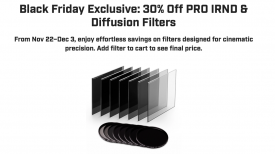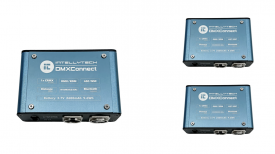The Angenieux MSU-1 Universal Cine Servo is built specifically for use with the EZ-1 and EZ-2 zoom lenses. The MSU-1 Universal Cine Servo with 3 Motors and Wireless Module from Angenieux is a removable lens drive unit that provides ENG-style control. The MSU-1 is made by Movcam for Angenieux.
With a lot of shooters who are used to using broadcast style ENG cameras with servo zooms migrating to larger sensor digital cinema cameras, there is a growing need for lenses that offer familiarity and convenience.
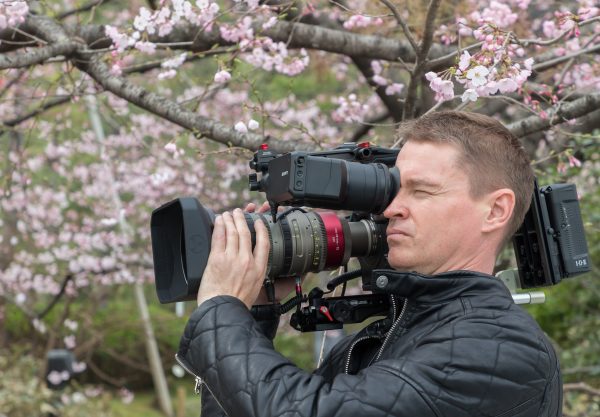
In recent years we have seen an increase in the number of Super35mm compatible servo zoom lenses that are now available. For a long time, the Fujinon Cabrio series were the only servo zoom lenses you could get, but that changed with the addition of the Canon CN7x17 KAS S 17 120mm T2.95-3.9 CINE SERVO, and the Fujinon XK6x20 20-120mm Cabrio PL-mount zoom. Canon also brought out the 18-80mm COMPACT-SERVO T4.4 and Canon 70-200mm Compact Servo Zoom T4.4 cinema style zooms that gave users the ability to use an optional servo zoom. Sony does have a few E-mount powered zooms as well, such as the FE PZ 28-135mm f/4 G OS and Sony E PZ 18-110mm f/4 G OSS, but those lenses don’t have a proper handgrip servo zoom.
I have always thought that a detachable handgrip servo zoom was a good idea. The trouble is, it’s virtually impossible to make a universal one that works with all lenses and brands. Zeiss tried making a proper handgrip servo zoom for the CZ.2 Compact Zooms a few years ago, and we saw quite a few prototypes, even dating back to NAB 2014. Unfortunately, Zeiss quit on the idea and it never went into production.
That brings me to the Angenieux MSU-1 Universal Cine Servo. This is a proper ENG-style lens control grip which offers all the same functionality, but with the addition of a few surprises. At first glance, the MSU-1 Universal Cine Servo looks almost identical to any ENG servo zoom controller that you may have seen before. This type of design has been around for a very long time and the reason servo zoom controllers are still built in this same way even today is a testament to just how well they work. Movcam, who makes the MSU-1 Universal Cine Servo for Angenieux stuck with the philosophy of if it ain’t broke, don’t fix it.
Features and build quality
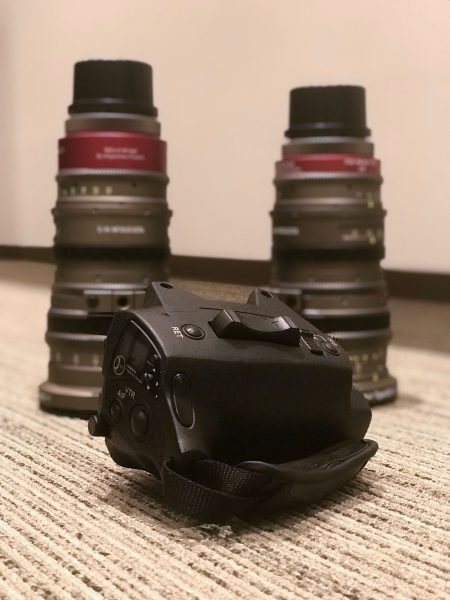
The Cine Servo housing is constructed out magnesium alloy with a Teflon coating and the adjustable hand strap is made from nylon and leather. The housing feels rugged despite its relatively low weight. The buttons and zoom rocker itself feel very similar to those you would find on a B4 ENG zoom lens.
The run/stop button on the handle can trigger the camera, while the traditional zoom rocker is augmented by an adjustable speed control. The grip offers further compatibility with the inclusion of Hirose and LEMO connectors. A built-in wireless module enables controlling the servo drive without a hard-wired connection. You can also control the servo with Canon or Fujinon standard ENG lens pan handles.
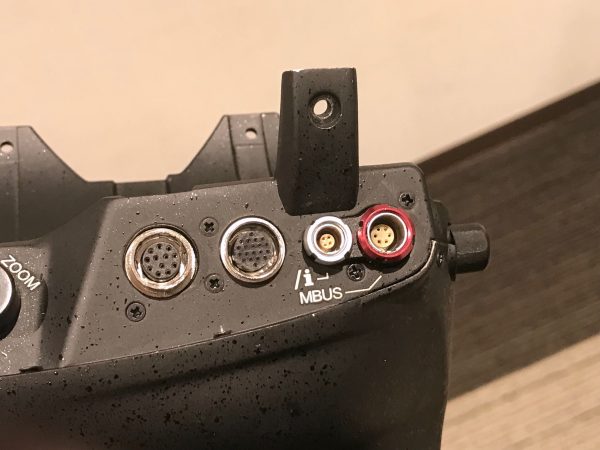
On the Cine Servo, there are three 0.8 MOD gears, a 12-pin Hirose, 20-pin Hirose, 6-pin LEMO, and 4-pin LEMO.
The Cine Servo weighs in at 720g (25.4oz) and draws a maximum of 35W. It can operate in temperatures of -4 to 131°F (-20 to 55°C).
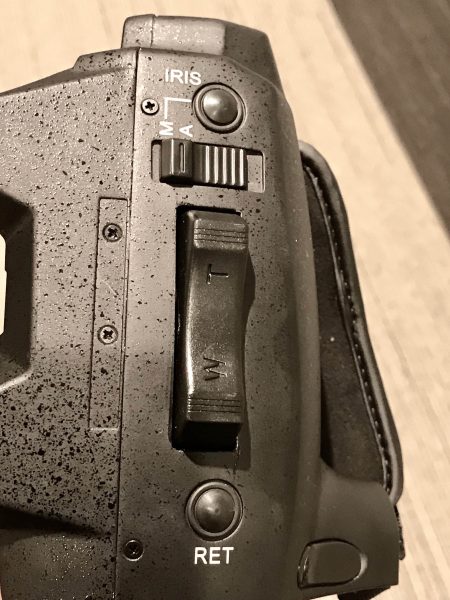
Further advanced features include an Auto Iris switch and switches to change both the zoom and focus between servo and manual control. There is also a return video switch on the top of the grip behind the zoom rocker.
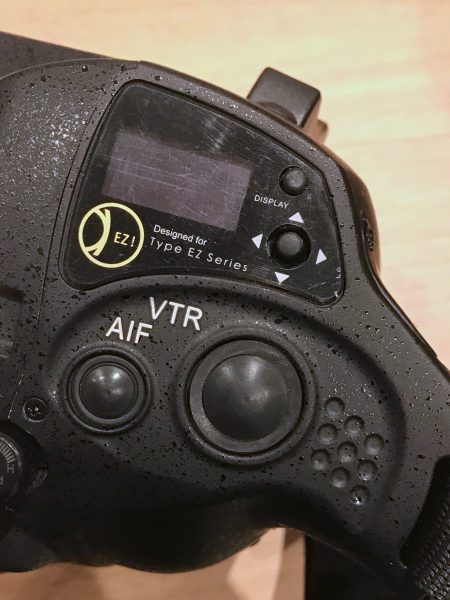
There is a AIF button that when pushed sets a memory point at the focal length you happen to be at, and then forces the zoom motor to move to the end of its tele range. It remains at this tele position as long as the switch is pushed. When the AIF switch is released the zoom motor goes back to the the previous memorized position.
An LED screen lets you enter a menu where you can change parameters such as:
System modes: analog demand, digital demand, wireless, local
Iris control mode: auto/remote
Wireless frequency select
Firmware upgrade
Trigger automatic calibration
Lens data selection
Wireless Control
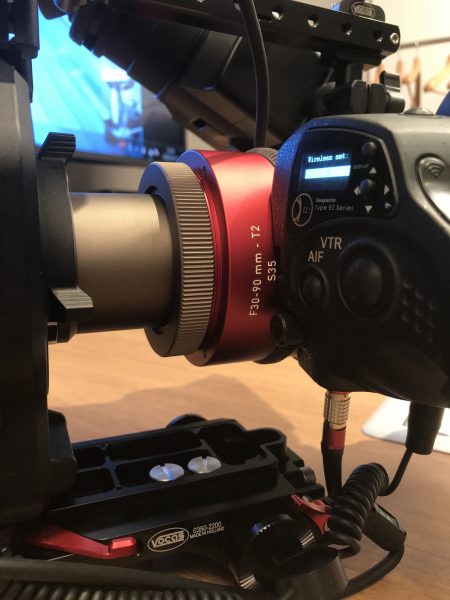
A built-in wireless module permits interfacing with Movcam wireless lens controllers, allowing you to remotely control iris, zoom, and focus without the need for lens motors. This is a very useful feature and it gives you a quick way of setting up and remotely controlling your lens if you are using it on say a crane, car mount or gimbal.
Zoom/Focus Demand and Compatibility Via the 20-pin adapter cable:
Fujinon
Canon
Microforce
Remote Controller Compatibility Via the 20-pin interface:
Cmotion
Preston
Compatibility
Compatible with Canon & Fujinon standard ENG lens pan handles:
20-pin Hirose – analog and remote control
12 Pin Hirose – direct to lens port on the camera
4-pin LEMO – “I” protocol communication
6-pin LEMO – MBUS port
Cooke I System – real-time data transfer, no storage
As I mentioned earlier, this Cine Servo is designed specifically for the Angenieux EZ-1 30-90mm T2 and EZ-2 15-40mm T2 lenses. The beauty of these lenses is that you can swap out the rear optical block and turn them into lenses that are capable of covering full-frame/VistaVision sensors. In the case of the EZ-2 15-40mm T2 it turns into a 22-60mm T3, and the EZ-1 30-90mm T2 turns into a 45-135mm T3.
This ability along with their compact size and weight makes the EZ series a very compelling option for a lot of shooters. The addition of being able to change the lens mount, and also add a servo zoom, makes these Angenieux zooms arguably the most versatile cine zoom lenses around.
Installation
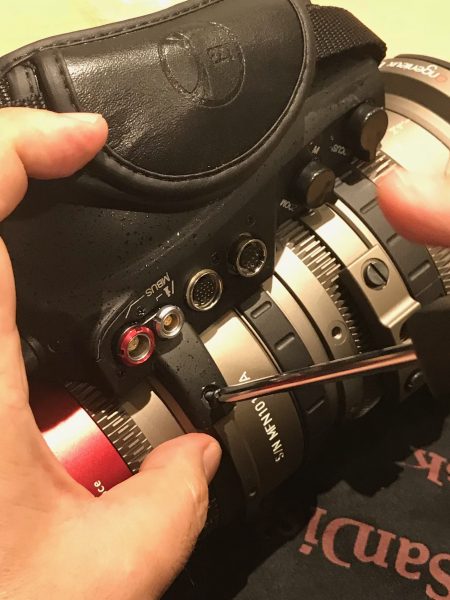
The MSU-1 is self-aligning and mounts with three screws and a guide pin. This is very straight forward to do and can be done in just a few minutes. Once it is on it feels nice and secure and doesn’t wobble around on the lens.
Price
The MSU-1 retails for $3,500 USD. If you don’t need to wirelessly control focus, iris and zoom, there is also the MSU-1A that just enables zoom control which is priced at $1,500 USD.
Competition and alternative options
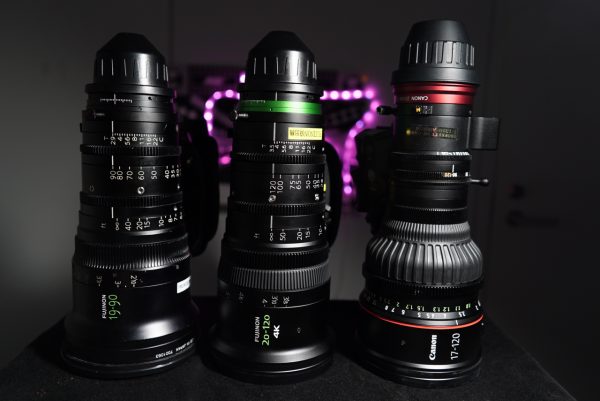
There are a handful of servo zoom lenses available from both Canon, Fujinon, and Sony at various price points. Fujinon has been doing Super35mm servo zooms for the longest time, their 19-90mm T2.9 Cabrio was released way back in 2012. Fujinon then added a 14-35mm T2.9 and the 85-300mm T2.9-4 Cabrio lenses. These lenses became very popular, but their price wasn’t for the faint of heart. In 2016 Fujinon released the more affordable 20-120mm T3.5 Cabrio. The servo zoom can be detached from the 20-120mm T3.5. The Fujinon Cabrio lenses only come in PL mount.
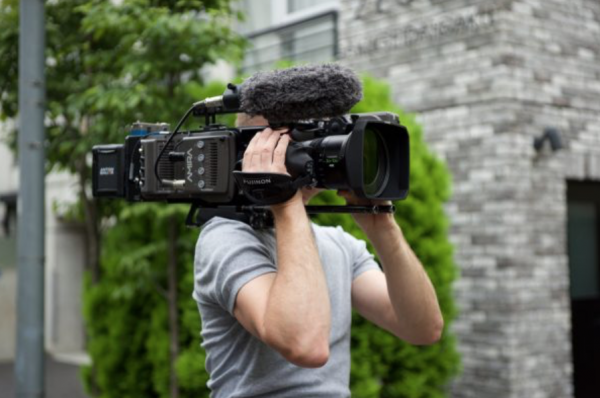
The 20-120mm T3.5 substantially lowered the entry price for getting a high quality Super35mm servo zoom lens. Subsequently, Fujinon had to lower the prices of their other Cabrio lenses.
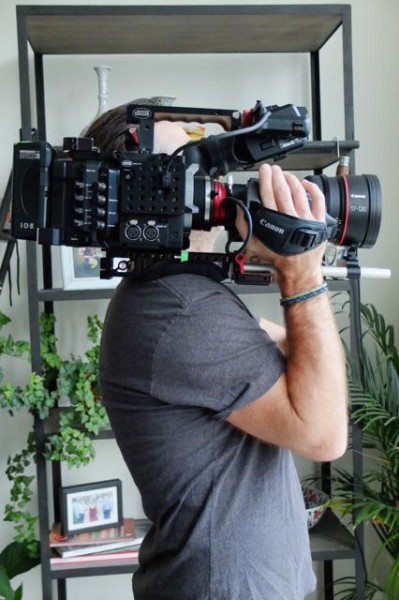
In 2014, Canon announced the Cine-Servo 17-120mm T2.95-3.9 zoom lens that comes in either EF or PL mount. This was in direct response to Fujinon’s very popular 19-90mm Cabrio. This lens become very popular with shooters who were moving from ENG cameras to Super35mm cameras such as the Sony F5 and F55. Like the Fujinon lenses, the servo grip can be dettached from the lens.
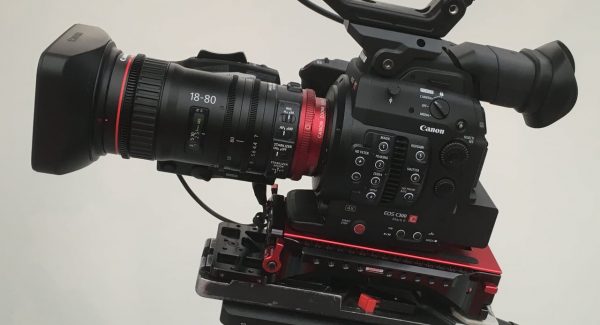
Canon also has two other servo zoom lenses available, the 18-80mm T4.4 and the 70-200mm T4.4. These lenses retail for $5,225 USD and $5,800 USD respectively, but they are only available in Canon EF mount.
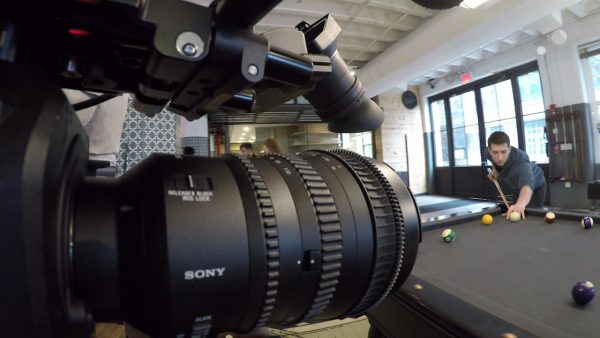
Sony has a couple of affordable servo zoom lenses available, but they don’t feature proper servo grips. Sony offers the E-mount PZ 18-110mm f/4 G OSS and the FE PZ 28-135mm f/4 G OSS. I wouldn’t call either of these cine lenses, but they are a lower cost alternative if you own a Sony E-mount camera.
At Newsshooter we have reviewed the Canon Cine-Servo 17-120mm T2.95-3.9, Fujinon 20-120mm T3.5 and the Canon 18-80mm and 70-200mm T4.4 lenses.
So let’s have a look at how the competition compares to the EZ-1 30-90mm T2 and EZ-2 15-40mm T2
Angenieux EZ-1 30-90mm T2
Full frame capable: Yes (with optional rear optics block)
Weight with MSU-1: 2.92kg
Lens mounts: Standard PL, can be user swapped to Sony E or Canon EF
Price with MSU-1: $14,000 USD ($17,000 USD with Super 35 and FF rear elements)
Angenieux EZ-2 15-40mm T2
Full frame capable: Yes (with optional rear optics block)
Weight with MSU-1: 2.92kg
Lens mounts: Standard PL, can be user swapped to Sony E or Canon EF
Price with MSU-1: $14,000 USD ($17,000 USD with Super 35 and FF rear elements)
Canon 17-120mm T2.95-3.9
Full frame capable: No
Weight: 2.9KG
Lens mounts: PL or EF
Price: $26,350 USD
Fujinon 19-90mm T2.9 Cabrio
Full frame capable: No
Weight: 2.7kg
Lens mounts: PL
Price: $24,800 USD
Fujinon 14-35mm T2.9 Cabrio
Full frame capable: No
Weight: 2.9kg
Lens mounts: PL
Price: $32,000 USD
Fujinon 85-300mm T2.9-4 Cabrio
Full frame capable: No
Weight: 3.0kg
Lens mounts: PL
Price: $2,7000 USD
Fujinon 20-120mm T3.5 Cabrio
Full frame capable: No
Weight: 2.4kg
Lens mounts: PL
Price: $13,499 USD
Canon 18-80mm T4.4
Full frame capable: No
Weight: 1.2kg
Lens mounts: EF
Price: $5,225 USD
Canon 70-200mm T4.4
Full frame capable: No
Weight: 1.25kg
Lens mounts: EF
Price: $5,800 USD
Sony E PZ 18-110mm f/4 G OSS Lens
Full frame capable: No
Weight: 1.1kg
Lens mounts: Sony E-mount
Price: $3,398 USD
Sony FE PZ 28-135mm f/4 G OSS Lens
Full frame capable: Yes
Weight: 1.2kg
Lens mounts: Sony E-mount
Price: $2,398 USD
Real world use
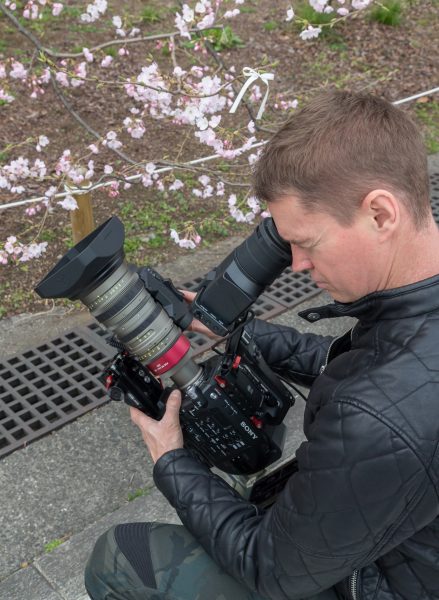
What I was most interested in seeing, was if the Angenieux MSU-1 Universal Cine Servo was easy to use and operate. If a servo zoom is difficult to set up and uncomfortable to use then there is little point in buying one.
The biggest problem I have found with most Super35mm servo zooms when you attach them to modern digital cinema cameras is that the position you need to put the camera in on your shoulder so it it properly balanced means that the lens is often too close to your head. This in turn means that your arm instead of being in a comfortable L shape is bent backwards on an angle. This is ergonomically very uncomfortable and it quickly leads to arm and wrist fatigue. 2/3″ B4 ENG cameras are still the most ergonomically friendly to use for hand held use. There is a reason their design hasn’t really changed in more than 25 years.
I tried the MSU-1 out on the popular Sony FS7 Mark II with the EZ-1 30-90mm and the EZ-2 15-40mm lenses. The EZ zooms were fitted with a Sony E-mount so they could go straight on the FS7 Mark II without the need for for an adapter. Because the FS7 Mark II uses a locking E-mount there was no need to use rods and a lens support.
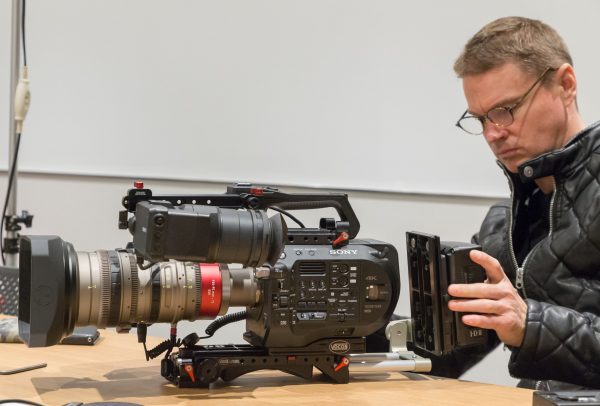
I decided to test the MSU-1 and the EZ zooms with the FS7 Mark II to see if you could create a reasonably compact ENG style set up. As I mentioned earlier the problem with most Super35mm servo zooms when you attach them to modern digital cinema cameras is that you need to move the camera so far back that the position where you end up holding the servo grip becomes compromised. Luckily when you fit the E-mount to the EZ zooms it actually makes the lens a few inches longer. This additional length that gets created is actually beneficial because it moves the servo grip into the right place for hand held shooting.
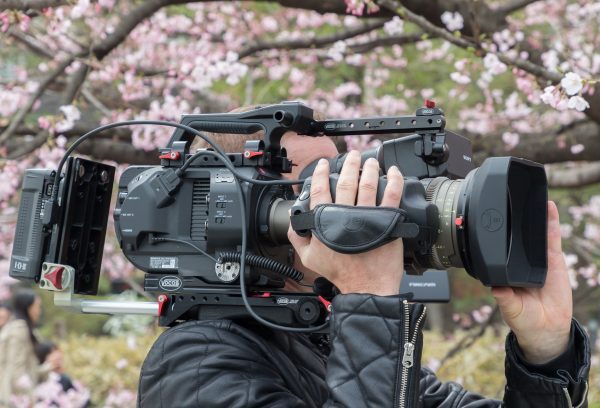
With the addition of a Vocas universal sliding baseplate, a V-lock battery mounting plate and a LCD loupe extension bracket I was able to get the FS7 Mark II to balance really nicely with the MSU-1 and EZ zooms. Unlike other options I have tried, I was able to have my arm in a nice L shape and there wasn’t any additional stress being put onto my wrist. Unfortunately, the trade off you have to make to get proper balance with a cine zoom and servo grip is that you need to make your camera platform longer and heavier and you need to spend quite a bit of additional money getting all the accessories needed to do it properly.
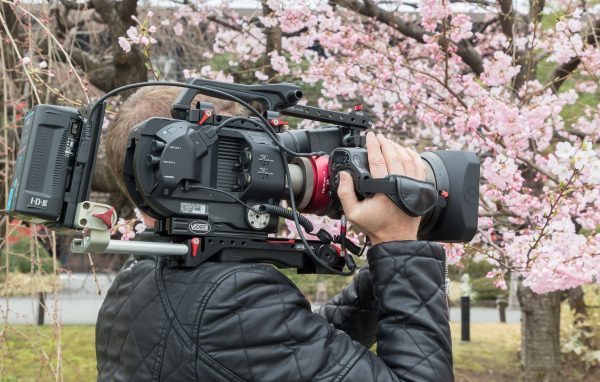
The MSU-1 itself is nicely made and it’s comfortable to hold on to. Anybody who has used B4 ENG lenses will be right at home with the functionality and familiarity of the MSU-1. I also found it really nice to use with a lens hood that Angenuiex also makes. The lens hood allows you to rest your left hand on the front of the lens while still allowing you to adjust focus. Having one hand here and the other on the servo grip itself makes for not only a comfortable shooting experience, but also a practical one.
While it works really nicely on the FS7 mark II I still have my doubts how well the MSU-1 and EZ zooms would work ergonomically on some other digital cinema cameras when it comes to creating a proper weight distribution. Sometimes it really does come down to trial and error to see what actually works.
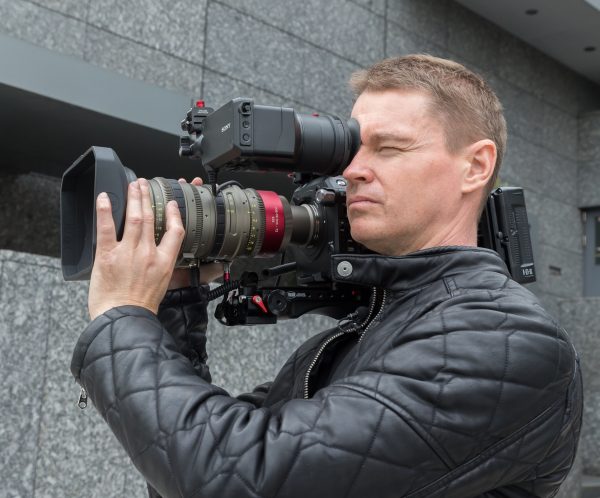
So now that we have addressed the ergonomics how is the performance of the actual servo zoom? Here is where it becomes a bit hit and miss. For a product that costs $3,500 USD I would expect it to work flawlessly. While the zoom works well when you use it at speed, if you try and do a slow zoom, it tends to stutter and not be smooth. This becomes even more apparent when you are zooming out rather than zooming in. I’m not sure why it does this, but If i had to guess I would say that the motors inside the MSU-1 aren’t strong enough to move the lens barrel smoothly at low speeds. Now whether this was just a problem with the unit I was testing I don’t know. I have contacted Movcam to see if they have seen the same problem on other units.
The other small problem you need to be aware of is that every time you power the MSU-1 up it needs to calibrate the lens again. This can take up to around 20 seconds and you need to be very aware of this if you are working in fast paced environments.
The last real world test I did was to see how it actually worked with the Movcam wireless lens controllers. As the MSU-1 has a built-in wireless module you can remotely control iris, zoom, and focus without the need for lens motors. This was extremely easy to set up as there is no need to hook up additional motors, cables and interface boxes. I could actually see myself using this set up quite a lot for jib, crane or car mount shots.
Is it worth having a servo zoom on lenses with a limited focal range?
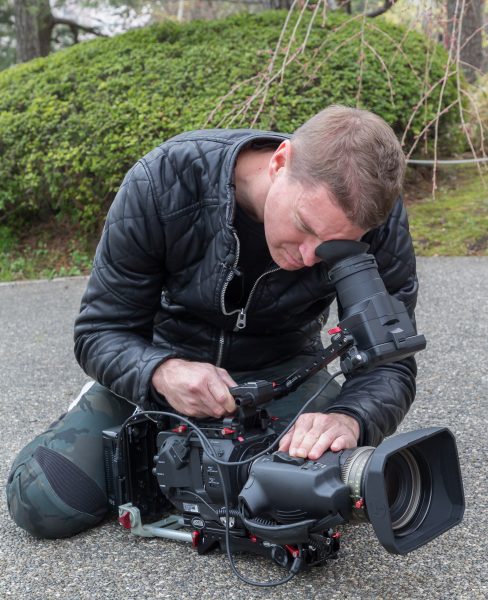
Whether you think having a servo zoom on a lens with a limited focal range is actually worth it really depends on what type of work you do. If you were shooting reality TV shows in a confined environment then the EZ-2 15-40mm with the servo zoom may make sense. I personally probably wouldn’t use a servo on a lens in a handheld configuration unless it had quite a large focal reach, like say a 19-90mm, 17-120mm, or 20-120mm. I would be more likely to use it with the EZ zooms if I had the camera on a crane, jib or car mount for example.
Conclusion
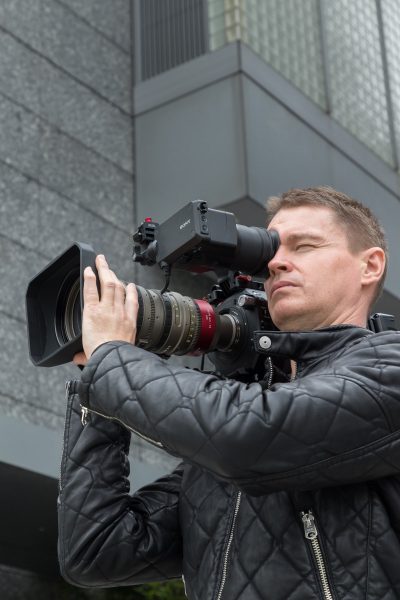
The MSU-1 build quality is good, it’s ergonomic to use (well, as ergonomic as it can be using servo zoom on todays digital cinema cameras) and it makes the already versatile Angenieux EZ zooms even more appealing. On the downside, not being able to do a slow, smooth zoom is a major let down.
It’s good to see a company make an optional servo zoom for their lenses. It’s certainly not an easy task as Zeiss found out. At $3,500 USD it’s certainly not going to appeal to everyone and it’s more likely that you will see it at rental houses rather than being bought by owner operators. In a lot of ways, the MSU-1A zoom only servo may well be the better option for $1,500 USD.
If you own or use EZ zooms then the MSU-1 Universal Cine Servo is certainly worth looking at, but it’s far from a perfect product. At this price it really should work perfectly, but that’s not the case. When you are selling a servo zoom it really has one main job, and that’s to enable precise and smooth zooming, unfortunately, from my testing the MSU-1 falls over in this key area.
Do you use a servo zoom? If so which one? Let us know in the comments section below.




